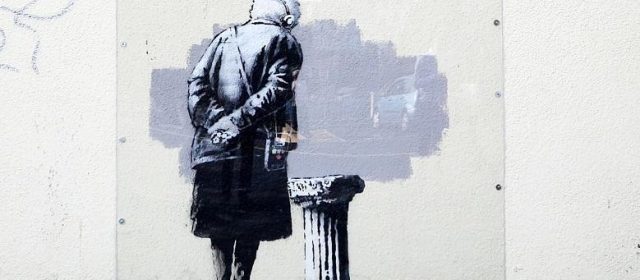Whose art is it anyway? High Court decides title to Banksy work
- Marta Griffin | January 15, 2017

The removal of a mural from a wall in Folkestone has been testing the legal boundaries of the ownership of street art
There is an ongoing public fascination with street art and particularly with the work of the street artist known as Banksy. Part of the fascination — for lawyers and non-lawyers — lies in the question: who owns street art? The artist or the owner of the building on to which it is sprayed or painted? The answer is not straightforward.
The first point to bear in mind is that there is a distinction between copyright in the work and the ownership of the physical thing on to which the work is sprayed. Copyright in an artistic work rests with the artist and gives the artist rights over its use and exploitation. But the artist may or may not own the physical thing on which the work is created: the canvas or, in the case of street art, the wall or fence. Before the art is created, the artist may own the paint, but once the paint is sprayed on to the wall, the paint becomes part of the wall, which, in turn, is treated as part of the land. So, if Banksy sprays a mural on a wall, ownership of the bricks on which is is painted, together with the paint itself, belongs to the owner of the wall.
The position is complicated further where the wall forms part of a building that has been let to a tenant. That was the position in a case recently decided by Mr Justice Arnold in the High Court in London. A mural attributed to Banksy, known as Art Buff, appeared on a wall in the heart of Folkestone’s Creative Quarter during the 2014 Folkestone Triennial, a big art event run by the Creative Foundation, a charity which promotes creativity and the arts as part of the regeneration of Folkestone. The tenant of the building arranged for Art Buff to be cut out of the wall and framed, and shipped to the US and offered for sale.
The Creative Foundation took an assignment of the title to Art Buff from the freehold owner of the building (so that, in law, it was treated as standing in the freeholder’s shoes, and started proceedings against the tenant). The tenant contended that it was obliged to remove the mural from the wall to comply with its repairing obligation in the lease, that the mural was graffiti and that the presence of graffiti resulted in disrepair, and that, because it was acting in compliance with its repairing obligations, the bricks that it removed became waste material that was owned by it and not by the freeholder.
The judge rejected both contentions. He accepted that it was arguable that the presence of graffiti put the wall into disrepair, but he decided that cutting out the bricks on which the mural appeared (rather than painting over or spraying off the mural) was not a reasonable way of remedying the disrepair and he decided that, in any event, even if the tenant had been acting in compliance with its repairing obligation, the materials removed from the building belonged to the landlord and not the tenant.
The result is a commonsense one: it would be very surprising if a tenant rather than a landlord acquires ownership of a valuable part of a building removed in this way. More importantly, from the point of view of the Creative Foundation, the mural will now be returned to Folkestone and put on display for the benefit of the local community and visitors.


twitter
pinterest
email
rss